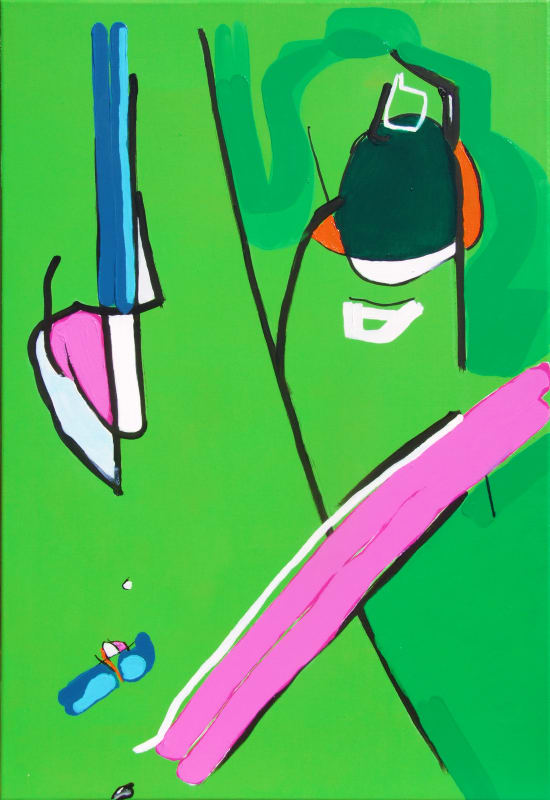Crinkled escape routes and other somewhat flat things
Project Space: William Bradley
Gleaming, pastel visions spread out across the gallery - images of cars, signposts, highways and flat, desert landscapes are obscured as if by fog. Existing in open-ended otherworldly plane, they are familiar yet, somehow, removed. Kristin Hjellegjerde is pleased to host new work by London-based Norwegian artist Martine Poppe in her second solo show at the gallery, Crinkled Escape Routes and Other Somewhat Flat Things. Meanwhile, the gallery's adjacent Project Space will feature works by London and Los Angeles-based abstract painter William Bradley.
Crinkled Escape Routes and Other Somewhat Flat Things combines the language of Martine Poppe's pale and ephemeral aesthetic with blurred landscapes, the gallery given over to a dialogue created by the juxtaposition of these dreamy canvases with images from the American wilderness as seen along the country's long rural highways. Buffalo skulls, 'no hunting' signs and yucca plants face off against ethereal surfaces so hazy their origins as photographs are hardly discernable. Transcending the specifics of the American landscape, they open up, evoking visions of spacious scenery and a less pressured existence. Assembled from images shot along the iconic Route 66, the works take the viewer on a journey through landscapes mental and external, shifting back and forth between the present and the part-remembered, part-constructed ideal; at the front of the gallery one is presented with an image of cars, yet the original photograph on which it is based has been crushed and crumpled up, like a time-worn billboard or poster.
These new works build on Poppe's previous body of work, as evident in her 2014 exhibition at Kristin Hjellegjerde, Anatidaephobia. Here, she explored the relationship (and distance) that evolved between a finished piece of work and its original subject. In her new works Poppe pushes this sensation further. The works maintain their soft aesthetic, allowing for "space to breathe," as she has explained, eschewing vivid colours and "hectic compositions." However, the works in Crinkled Escape Routes see the artist explore new ways of creating. By working from blurred source photographs, the brush mark is placed at the forefront, allowing her gestures to create landscapes all their own. "The subsequent fields of pixel-like marks open up spaces in which I make my decisions more apparent," she says. "I leave behind something open-ended and revealing on the surface." As with previous shows, Poppe has also included figurative works in which part of the canvas is left exposed. In this case, she uses taffeta - which, when contrasted with the blurred landscapes, "enhance the experience of the work's materiality", increasing the sense of contemplative calm that prevails throughout the space.
One of the key tenets to Poppe's work has been its nuanced use of the visible made invisible, and vice-versa - of barely-there marks and markers that are at times hardly visible to the human eye. At other times, they are thematically present yet so far removed from their original source image as to be barely recognisable. In this form, they become instead a leitmotif, a narrative element softly gliding along her canvases, in view yet obscured. Her works allude both to the use of photographs as source material as well as the metamorphosis of landscape. "As always my work is very conscious of its origins in photography," she explains. As such, these interventions, such as the blur, never overpower or drown out Poppe's soft, visual style. "I'm developing the sense of meditative calm in the work, but also aiming to be more generous with my approach."
Meanwhile, in the Project Space London and Los Angeles-based abstract artist William Bradley displays new paintings. Where his practice continues to examine the painted depiction of painterly codes, this new body of work looks increasingly towards digital intervention, such as Photoshop, as a tool for the manipulation of these codes. "Digitally modifying my scanned watercolours," he explains, removes them "yet another step away from the immediacy of the original authorial mark." The resultant painting may reference gestural marks or codes from the history of Abstraction, but this is coloured by its digital pre-planning. "Thus the gestural elements of the work are less about the intuitive use of paint," says Bradley, "and more a device concerned with the combining of source material and reference." By digitally modifying watercolours - first scanned - Bradley is able to take a step away from the original source material itself. By scanning and manipulating the painting, Photoshop puts distance between the original creation and the final work - his painterly mark becomes abstracted, adding a second layer to his already abstract, gestural work. Since moving to California, Bradley's work has also seen a shift in its colour palette. "The colours have become more vibrant," he explains, with different colour relationships and compositions creating works "much looser, with more movement" than previous object/form derived compositions.



